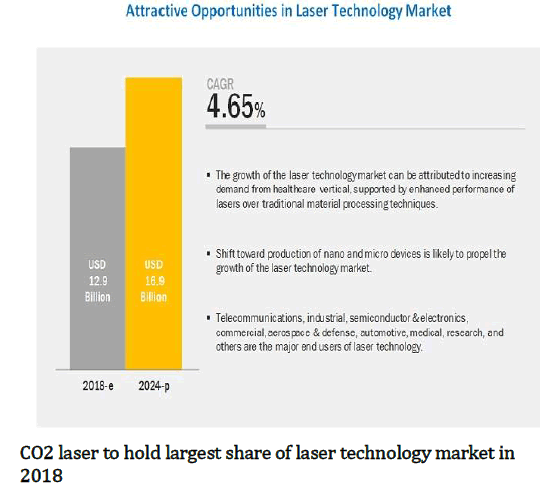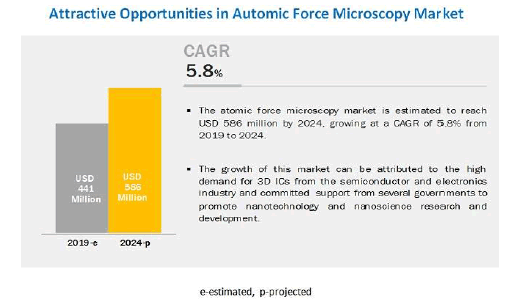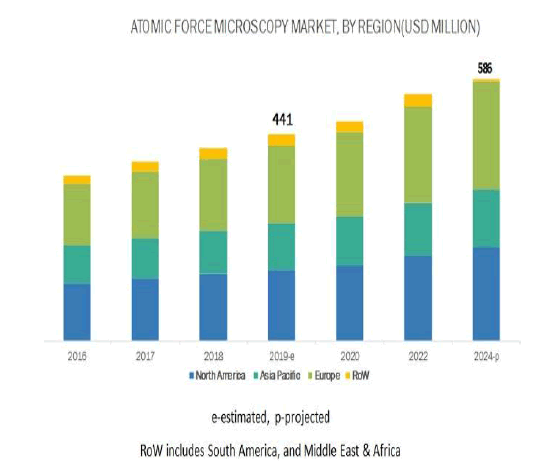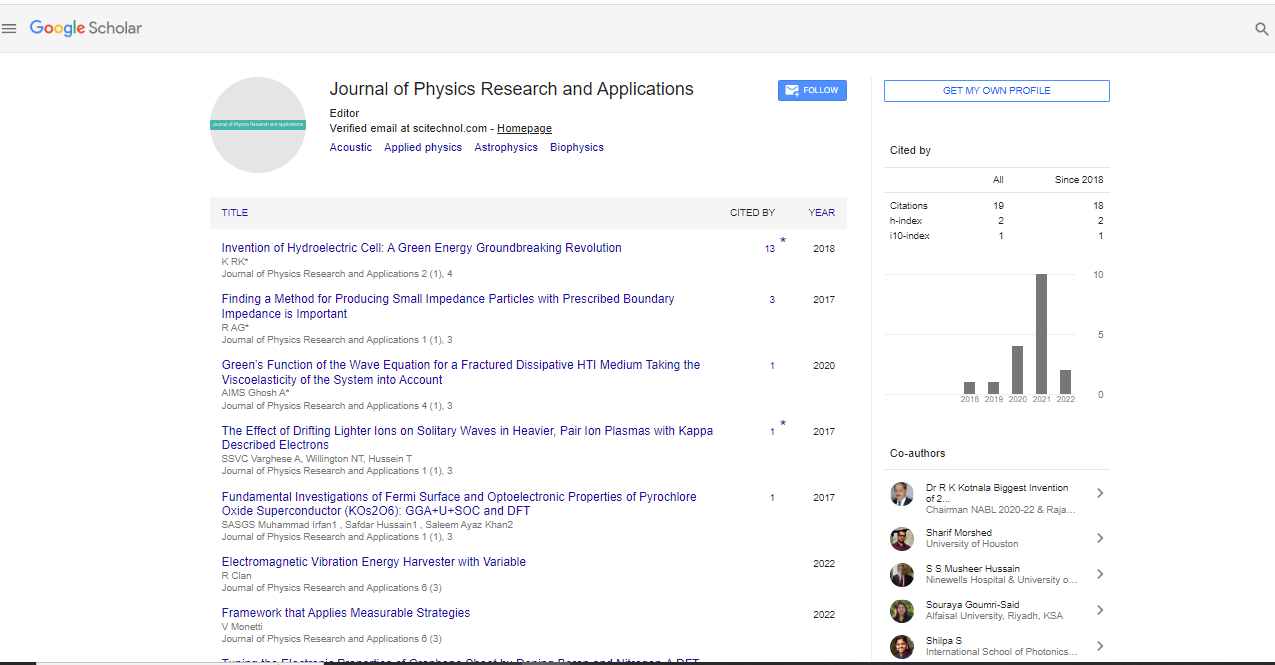Market Analysis, J Phys Res Appl Vol: 3 Issue: 2
Laser Technology Market by Type (Carbon Dioxide Laser, Fiber Laser, and Solid State Laser), Revenue (Laser Revenue and System Revenue), Application (Laser Processing and Optical Communications), End User, Geography – Global Forecast to 2024
Hakima Mokrane
Assistant professor, laboratory of astrophysics & astrochemistry, Expaceo, France, E-mail: v hakima.mokrane@gmail.com
Keywords: Laser Technology , Laser Revenue and System Revenue
Market Analysis
The overall laser technology market is expected to grow from USD 12.9 billion in 2018 to USD 16.9 billion by 2024, at a CAGR of 4.65%. Huge demand from the healthcare vertical, enhanced performance over traditional material processing techniques, and shift toward production of nano and micro devices are the key factors driving the growth of this market.

CO2 laser type accounts for the largest share of the market. The leading position, in terms of market size, of CO2 laser can be attributed to its considerably compact sized for a sealed laser, suitability for a wide range of wavelengths, and utility in laser cutting, welding, structuring, perforating, drilling, and laser marking applications. A CO2 laser is a continuous wave laser of high power, which has a wide range of commercial, industrial, and military applications.
Market for system revenue to hold larger share of laser technology market in 2018
The market for system revenue accounts for the larger share of the market. The leading position, in terms of market size, of the system revenue segment can be attributed to the ability of the systems in performing a wide range of functions, which expands their utility across several verticals, such as industrial, commercial, automotive, and medical. System revenue covers the revenue generated from the sales of several types of laser systems, such as systems for marking & engraving, welding & brazing, cutting & scribing, drilling, cladding & coating, annealing, material removal, and other multi-function laser systems.
Laser processing application to hold largest share of laser technology market in 20
Laser processing application accounts for the largest share of the market. The leading position of laser processing, in terms of market size, can be attributed to its ability to provide better quality and reliability and more precise output than conventional mechanical methods. Laser processing involves using laser for applications such as materials processing, micro processing, and advanced processing.
Telecommunications end-user vertical to lead laser technology market during forecast period
The telecommunications end-user vertical accounts for the largest share of the market. The leading position of this vertical, in terms of market size, can be attributed to laser technology’s ability to enable faster and secure data transmission, while consuming low power. Laser communications not only provides high data transfer rates with low power consumption but is also a highly secure medium for data transmission. Apart from data transmission, in the telecommunications vertical, laser technology is also used for tasks such as signal strength optimization, precise network design, and proper tower placement.

Market in APAC expected to grow at significant rate during 2018–2023
Continuous demand for cost-effective and fast processing laser machine tools from semiconductor, automotive, industrial, and telecommunications verticals are expected to drive the growth of the laser technology market in APAC. APAC has been ahead in terms of adoption of laser technology products and solutions compared to other regions. The region’s huge population, increasing R&D investments, and growing manufacturing and electronics sectors are expected to drive the growth of the market.
Key Market Players
A few major companies in the laser technology market are: Coherent (US), IPG Photonics (US), Trumpf (Germany), Lumentum (US), Jenoptik (US), Novanta (US), Lumibird (France), LaserStar (US), Epilog Laser (US), and MKS Instruments (US). Organic growth strategies, such as product launches, is a focus of many of the above.
Prominent players have adopted product launches, followed by mergers & acquisitions, as the key business strategy to strengthen their positions in the laser technology market. For instance, in November 2017, Coherent (US) launched the Total Power Control, a laser having application in multiphoton excitation (MPE) microscopy. Based on acousto-optic (AO) technology, this laser enables high-power output and modulation on tunable femtosecond output.
Major Market Developments
• In October 2018, Trumpf (Germany) launched the TruLaser Cell 7040, a 3D laser system that can be used for cutting and welding application in 2D or 3D.
• In May 2018, Coherent (US) acquired O.R. Lasertechnologie, a German laser technology provider, enabling it to enhance its laser technology product portfolio.
• In December 2017, IPG Photonics (US) acquired Laser Depth Dynamics, a Canadian laser technology solutions provider, enhancing its laser product portfolio for welding applications.
The atomic force microscopy market was valued at USD 441 million in 2019 and is projected to reach USD 586 million by 2024; it is expected to grow at a CAGR of 5.8% during the forecast period. The key drivers of atomic force microscopy is committed support from several governments to promote nanotechnology and nanoscience research and development. Also, high demand for 3D ICs from semiconductor and electronics industry is is expected to lay new growth opportunity for atomic force microscopy market during the forecast period.

By offering, the AFM is the largest contributor in atomic force microscopy market during the forecast period
The market growth of AFM is attributed to its versatility and dominance for studying samples beyond nanoscales. It is versatile because it can obtain three-dimensional topography, and it also meets the requirements of scientists and engineers by offering measurements for several types of surfaces. It can generate images at atomic resolution with angstrom scale resolution height information, with least sample preparation. which it uses to decode the captured image to produce a new type of image that could benefit a vision system.
Industrail grade AFM accounts for the largest market size of the atomic force microscopy market
Industrial grade is expected to grow at a significant rate between 2019 and 2024. There is a great importance of high-quality images to detect defects in miniaturized products. Hence, industrial grade AFM are more in demand owing to their high precision in detecting and visualizing even the smallest surface structures and defects in nanomaterials.
Materials science application to account for the largest market size of atomic force microscopy market during the forecast period
For materials science research, AFM acts as a powerful tool as it deals with the discovery and design of new materials including polymers, metals, alloys, ceramics, and biomaterials. The atomic force microscopy technique can examine any kind of samples, such as polymers, adsorbed molecules, films or fibers, and powders in air or liquid. An increasing focus on research in materials science is expected to boost the demand for AFM in this advancing application. Thus, materials science is an interdisciplinary field integrating elements of applied physics and chemistry.

 Spanish
Spanish  Chinese
Chinese  Russian
Russian  German
German  French
French  Japanese
Japanese  Portuguese
Portuguese  Hindi
Hindi 
